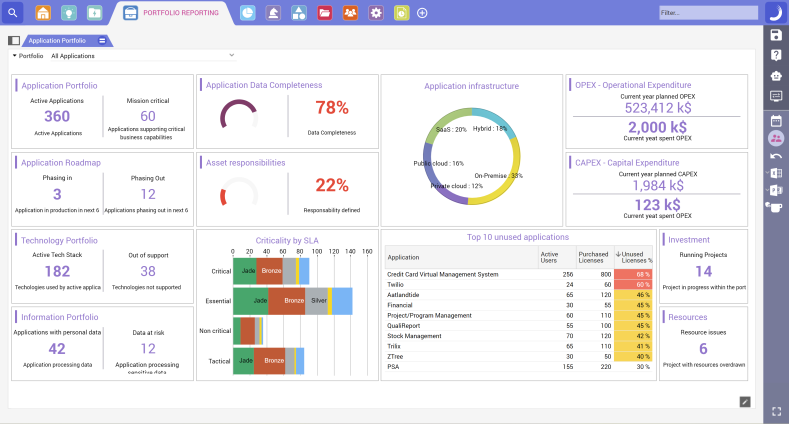As CIOs, PMO-level decision-makers, and IT program managers know well, overseeing IT project portfolios and bringing them to fruition can be quite challenging. And the data backs this up: an extensive report about the industry has revealed that only 31% of IT projects are delivered successfully!
Much like traditional portfolio management, IT project portfolio management focuses on maximizing value, optimizing resource allocation, and ensuring that investments align with the strategic goals of an organization. However, IT projects come with their own unique challenges, requiring tailored strategies and tools to maximize ROI.
Key challenges when managing IT project portfolios
IT portfolio project managers must navigate both the relentless pace of technological change and the growing demands of compliance and security. Both pose unique challenges that can disrupt plans and divert resources if not proactively addressed.
Keeping pace with rapid technological change
One of the primary challenges in managing IT project portfolios lies in the ever-changing nature of technology itself. The fast pace of innovation makes long-term planning a challenge, meaning IT portfolio management must remain highly responsive.
Take, for example, the sudden rise of GenAI in late 2023. The widespread availability of advanced automation capabilities has significantly impacted many organizational strategies, prompting overnight reviews of tech stacks, retraining of teams, and fast-tracking of digital transformation initiatives.
Traditional data analytics has quickly made way for predominantly AI-powered solutions and tools like automated code generation, intelligent chatbots, and AI-driven decision support systems have rapidly become integral to operations.
It’s a clear reminder of how quickly priorities can shift—and how yesterday’s well-laid plans can become today’s roadblocks.
The load of compliance and protocols
Beyond technology, external factors such as regulatory compliance and governance also contribute to the challenges of managing IT project portfolios. After all, IT systems must adhere to strict security measures, such as GDPR in Europe or HIPAA in the United States, as well as industry-specific regulations like those governing the handling of medical data and products. A well-managed IT portfolio ensures that these security measures are in place, mitigating the risk of costly fines and legal repercussions.
IT security norms and standards are not only essential for compliance—they are crucial for ensuring business continuity. By implementing robust security protocols, companies can keep their systems operational even in the face of external threats. This minimizes downtime and ensures the business can continue to function smoothly without major disruptions.
Adding to this are the challenges of balancing competing priorities, such as aligning projects with business objectives while managing limited resources.
How can you overcome these hurdles and get the most ROI out of your IT project portfolio management?
Maximizing ROI in IT project portfolio management: 3 best practices
IT leaders must take a strategic and multifaceted approach—one that combines the right mix of methodologies, clear stakeholder communication, and ongoing performance monitoring and improvement. Each element reinforces the next, helping drive alignment, agility, and long-term value.
1. Embrace the right methodologies
When it comes to IT project portfolio management methodologies, Agile is the elephant in the room. The close relationship between IT and Agile cannot be overstated, as the Agile framework was specifically designed to manage IT / software projects.
However, Agile has evolved into a multifaceted methodology, encompassing various methods, processes, tools, and frameworks, including:
- Kanban: A work management method that focuses on delivering tasks just-in-time, ensuring efficient workflow and minimizing delays.
- Scrum: An agile framework frequently used in software development, where teams hold regular meetings to assess progress during a specific development phase, known as a Sprint.
- Lean: A methodology centered around eliminating waste by visualizing project evolution across value streams and removing anything that doesn’t add value to the customer.
IT portfolio leaders must carefully choose the Agile approach—or combination of approaches—that best fits their unique project environment and organizational culture. That said, even within software development, there are scenarios where other methodologies may be more appropriate, especially when dealing with strict deadlines, sensitive data, or large teams. When a project has a fixed deadline and clear requirements, Agile's flexibility may not be the best fit, and a more structured approach could offer greater benefits.
Success story: a hybrid approach to IT project portfolio management in energy
Having technology tools that support and integrate multiple methodologies is crucial. For example, implementing an SPM solution proved to be a game-changer for a leading utility company whose IT team had previously relied on multiple standalone solutions and methodologies across a broad, diversified portfolio.
The absence of integration between these solutions led to significant inefficiencies for project managers—and changed for the better with the implementation of an integrated, enterprise-level PPM solution.
The company is now able to run hybrid portfolios using Agile, SAFe and Waterfall methodologies in one single platform, resulting in improved data quality, decision-making, and efficiency.
Selecting the right IT PPM methodologies also lays the groundwork for smoother stakeholder communication, which is essential for maximizing the overall outcomes of IT portfolios.
2. Streamline stakeholder communication
The relationship between IT managers and business stakeholders has long been marked by disconnects and misunderstandings.
This may be largely due to frequently competing priorities and goals, with IT managers focused on technical aspects, infrastructure stability, and system performance, while business stakeholders are more concerned with business outcomes, profitability, and customer satisfaction. These differences are often compounded by a communication gap, as technical jargon doesn’t always translate across teams.
Bridging this divide requires more than just clearer language. It demands a shared understanding of value, greater visibility into the portfolio, and ongoing alignment between business strategy and IT execution.
Success story: using tools to improve alignment between IT leaders and business stakeholders
To address these communication challenges, IT project portfolio managers should actively involve other stakeholders throughout the project lifecycle to ensure their needs and expectations are met.
For example, CIOs can leverage IT roadmaps to communicate their strategy to stakeholders, keeping them informed on project progress and facilitating trade-off decisions. IT managers should also tailor their communication to the audience, ensuring that technical details are explained in a way that is meaningful to business stakeholders.
Bridging this gap requires the right IT project portfolio management and collaboration tools. For example, Bosch Global Software Technologies (BGSW), the professional services division of technology giant Bosch, lacked a shared view on projects, making it impossible to ensure project demands were met quickly and efficiently.
When the organization decided to implement a leading PPM solution, the vendor team brought multiple BGSW stakeholders into the process, including IT leaders, project managers, and even end users, to scope out the strategy. This allowed BGSW to meet the needs of everyone involved at each level.
A member-owned credit union, Washington State Employee Credit Union (WSECU) also turned to PPM tools to bring more discipline to its project management processes and align execution with strategic priorities. By involving stakeholders across departments and centralizing project data, the organization improved visibility, fostered cross-functional collaboration, and ensured projects stayed connected to business goals.
3. Leverage tools for continuous monitoring and improvement
Regular assessment, evaluation, and adjustment—together known as adaptive management—form the foundation for maximizing ROI across project portfolios. This vigilant approach is particularly important in compliance-driven, resource-constrained, and rapidly-changing environments—all no doubt familiar to CIOs and IT leaders.
Continuous monitoring is a cyclical, iterative process that involves tracking every aspect of your IT portfolios—KPIs, OKRs, financials, resource management, strategic alignment, and risk—and making timely, data-driven decisions. The adaptive approach is characterized by early risk identification and mitigation, proactive adjustments, and real-time resource reallocation.
This supports every aspect of the health, vitality, and alignment of your portfolios. By embedding adaptive practices into portfolio governance, IT leaders create a transparent, feedback-rich environment where optimization of ROI and process improvement is always front and center.
More than that, continuous reporting helps to prove the value of your investments and initiatives, also facilitating the all-important stakeholder-IT manager communication we just touched on.
In reality, continuous monitoring is perhaps best seen not necessarily as a “best practice,” but an enabler of all other best practices. IT project portfolio leaders will already understand its importance, but they might be unfamiliar with advances in tools at their disposal. Thankfully, what once would have required a superhuman level of manual management has become a much more efficient process.
That’s because modern portfolio management software solutions boast various features purpose-built for IT portfolio leaders wanting to supercharge their adaptive practices and commitment to continual improvement. This includes pre-built reports, dynamic dashboards, “what-if” scenario planning, prioritization models, real-time health scoring, risk tracking, strategic alignment visualization, and integrated resource planning—to name a few.

The importance of the right toolset
Managing IT portfolios effectively isn’t just about process–it’s about having the right support system in place.
Modern IT PPM tools underpin and support you in embracing all of the best practices we mentioned earlier, providing real-time insights, facilitating collaboration, and helping manage risks, ultimately driving more efficient decision-making and ensuring that IT investments deliver the highest possible value.
The most effective solutions also support both Agile and traditional approaches, leverage AI for data automation and resource forecasting, and help CIOs tackle challenges like stakeholder management and cybersecurity. Importantly, a top-tier solution vendor acts as a true partner, guiding teams throughout implementation and user adoption to ensure lasting impact.
Want to see how Planisware can help you oversee your IT project portfolio management and transform your ROI? Book a personalized demo today.


